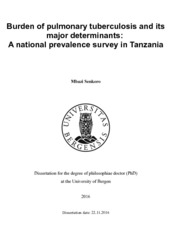| dc.contributor.author | Senkoro, Mbazingwa Fikeni | en_US |
| dc.date.accessioned | 2016-11-29T10:39:11Z | |
| dc.date.available | 2016-11-29T10:39:11Z | |
| dc.date.issued | 2016-11-22 | |
| dc.identifier.isbn | 978-82-308-3214-1 | en_US |
| dc.identifier.uri | https://hdl.handle.net/1956/13140 | |
| dc.description.abstract | Tuberculosis is a major public health problem in Tanzania. The burden of tuberculosis in the country is monitored through a routine notification system. Although the routine tuberculosis surveillance data have been consistent over the years, there are still areas of uncertainty, which make the data not easily translated into exact estimation of tuberculosis disease burden. The lack of information on the true burden of tuberculosis disease in Tanzania stimulated a decision to conduct a national tuberculosis prevalence survey to provide the context in which other available data such as tuberculosis notification and mortality can be re-assessed. The prevalence survey also provided us with a unique opportunity to look at other factors which are important in tuberculosis control at the community level. The survey provided us with an opportunity to have add-on studies to study the health careseeking behaviour of individuals with symptoms of tuberculosis and to assess factors associated with tuberculosis at a community level in a national scale. Our prevalence survey conducted in 2012 showed that the weighted prevalence for sputum smear-positive was 249 per 100000 adult population and for bacteriologically-confirmed tuberculosis cases it was 293 per 100000 adult population. The bacteriologically-confirmed tuberculosis prevalence was markedly higher in mainland Tanzania (298/100000 adult population) than in Zanzibar (124/100000 adult population). The prevalence was twice as high in men as in women. The highest prevalence was found in the oldest age group of 65 years and older. In addition, low socioeconomic position was associated with higher tuberculosis prevalence. Individuals 45 years or older constituted 55% (71/129) of the identified smear positive cases, but just 28% (6793/24648) of the notified tuberculosis cases. Chest X-ray (CXR) screening identified more tuberculosis cases than symptoms screening. Weighted for the prevalence of HIV in the notified new smear-positive cases, the overall case detection of incident tuberculosis cases in 2012 was between 37% and 48%. A study using data from the prevalence survey showed that of the 3,388 individuals with presumptive tuberculosis, only 1,053 (31.0%) had sought care for their symptoms at the time of the survey. Compared to persons with only cough and/or hemoptysis, those patients with additional symptoms were more likely to seek care. Care seeking at health facilities with tuberculosis diagnostic capacity was done by 42.3% of the individuals with presumptive tuberculosis. For individuals with presumptive tuberculosis who did not seek any care, lack of money (29.6%) and perceiving symptoms as not serious enough (23.9%) were the main reasons given for not seeking care. Another study based on data from the survey showed that tuberculosis was more common in persons aged 25-34 years, and 55-64 years compared to persons aged 15- 24 years. Tuberculosis was more common among men than women, and also more common among individuals with a low body mass index (BMI) than those with normal BMI. The associations with HIV and diabetes were not statistically significant, but their statistical power was low due to few events/cases. Population attributable fraction was 2% for diabetes and 3% and for HIV. In conclusion, our results showed that the prevalence of sputum smear-positive and that of bacteriologically-confirmed pulmonary tuberculosis in the adult population were higher than previous WHO estimates. Many presumptive tuberculosis patients had not sought care for their symptoms, and among those who did, the majority went to sites with limited tuberculosis diagnosis capacity. Some factors associated with tuberculosis were identified. On a population level, HIV and diabetes have no major effect on prevalent tuberculosis from which future transmission can derive. | en_US |
| dc.language.iso | eng | eng |
| dc.publisher | The University of Bergen | eng |
| dc.relation.haspart | Paper I: M. Senkoro, S. Mfinanga, S. Egwaga, R. Mtandu, V. Kamara, B. Doulla, L. Fundikira, A. Kahwa, R. Shirima, N. Range, S. G. Hinderaker, F. van Leth. Prevalence of pulmonary tuberculosis in adult population of Tanzania: A national survey, 2012. International Journal of Tuberculosis and Lung Disease 2016, 20(8):1014-1021. Full text not available in BORA due to publisher restrictions. The article is available at: <a href="https://doi.org/10.5588/ijtld.15.0340" target="blank">https://doi.org/10.5588/ijtld.15.0340</a> | en_US |
| dc.relation.haspart | Paper II: M. Senkoro, S. G. Hinderaker, S. G. Mfinanga, N. Range, D. V. Kamara, S. Egwaga, F. van Leth. Health care-seeking behavior among people with cough in Tanzania: findings from a tuberculosis prevalence survey. International Journal of Tuberculosis and Lung Disease 2015; 19:640-646. Full text not available in BORA due to publisher restrictions. The article is available at: <a href="https://doi.org/10.5588/ijtld.14.0499" target="blank">https://doi.org/10.5588/ijtld.14.0499</a> | en_US |
| dc.relation.haspart | Paper III: M. Senkoro, A.M.V. Kumar, P. Chinnakali, S. G. Mfinanga, S. Egwaga, V. Kamara, F. van Leth, S.G. Hinderaker. Population impact of factors associated with prevalent pulmonary tuberculosis in Tanzania. International Journal of Tuberculosis and Lung Disease 2016, 20(10):1326-1333. The article is available at: <a href="http://hdl.handle.net/1956/13139" target="blank">http://hdl.handle.net/1956/13139</a> | en_US |
| dc.title | Burden of pulmonary tuberculosis and its major determinants: A national prevalence survey in Tanzania | en_US |
| dc.type | Doctoral thesis | |
| dc.rights.holder | Copyright the Author. All rights reserved | |
| dc.identifier.cristin | 1404865 | |
